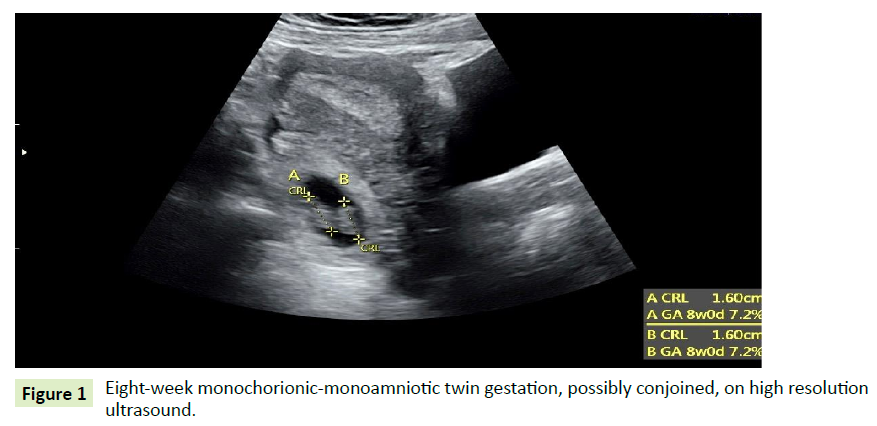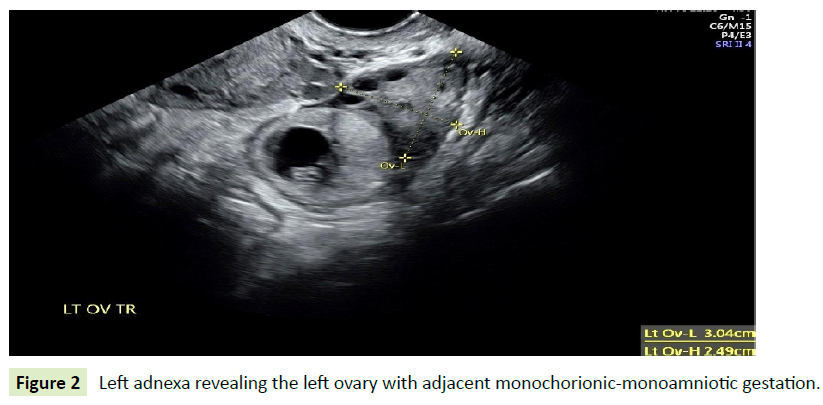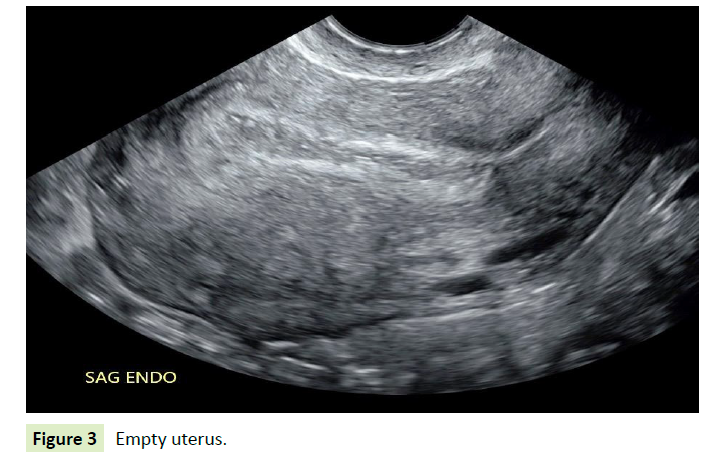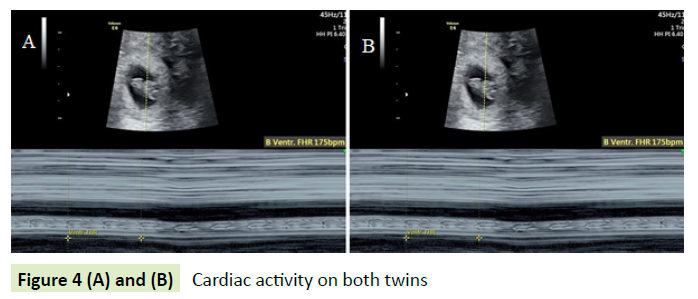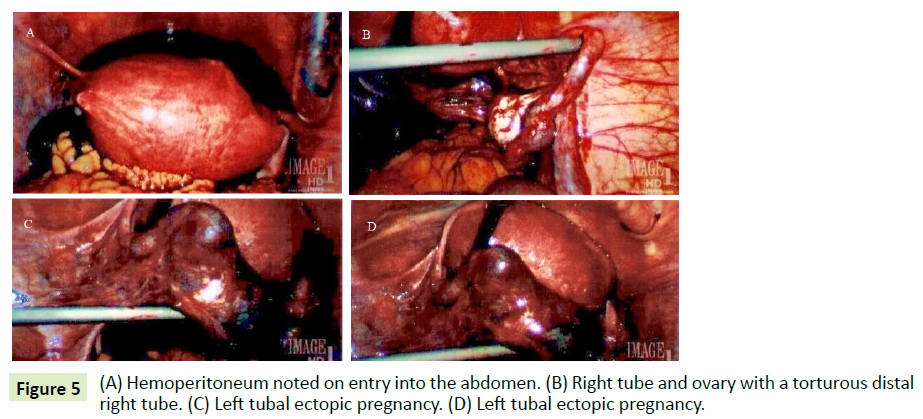Wilde NE*, Reihe CA, DeMoss CM, Henke SJ and Christensen RM
Department of Gynecology and Obstetrics, University of South Dakota Sanford School of Medicine, Vermillion, SD-57069, USA
- *Corresponding Author:
- Nicholas E. Wilde
Department of Gynecology and Obstetrics
University of South Dakota Sanford School of Medicine
Vermillion, SD-57069, USA
Tel: +1-605-553-8956
E-mail: Nicholas.Wilde@coyotes.usd.edu
Received Date: May 24, 2021; Accepted Date: June 16, 2021; Published Date: June 24, 2021
Citation: Wilde NE, Reihe CA, DeMoss CM, Henke SJ, Christensen RM (2021) Unilateral Monochorionic-Monoamniotic Twin Ectopic Pregnancy: A Rare Case Report during a Global Pandemic. Gynecol Obstet Case Rep Vol.7 No.6:140.
Keywords
Ectopic; Tubal; Twin pregnancy; Monochorionic; Monoamniotic;
Salpingectomy; Corona virus; COVID
Introduction
Ectopic pregnancy refers to an extrauterine pregnancy, most
commonly occurring in the fallopian tube (96 percent) [1].
Although only affecting approximately 1-2 percent of all
pregnancies, this complication has potentially life-threatening
consequences if not appropriately diagnosed and managed [2].
The most important risk factor of ectopic pregnancy is a history
of prior ectopic pregnancy or pelvic/tubal surgery, with other
significant contributors including pelvic inflammatory disease,
cigarette smoking, congenital anomalies, tumors, and adhesions
affecting the anatomy of the fallopian tubes [3]. Even rarer,
the incidence of twin tubal ectopic pregnancy was previously
estimated to be 1:125,000. However, this may underestimate
current incidence as a shift towards conceiving at an older
maternal age and Assisted Reproductive Technology (ART), both
of which increase rates of multifetal gestation, become more
common [4].
There are very few documented cases of monochorionicmonoamniotic
live twin ectopic pregnancy, according to our
literature review [5]. This, in conjunction with the likely conjoined
nature of the fetuses seen on imaging, suggests our case is an
exceptionally rare event.
Nonetheless, diagnosis and treatment for this unusual pregnancy
complication remains the same as for a typical ectopic pregnancy.
Understanding the management options is critical given the
significant potential mortality and morbidity for the mother.
Comprehensive history taking and close patient follow up, as well as utilization of high-resolution transvaginal ultrasonography
and other diagnostic modalities, allow for these risks to be
substantially mitigated. Here we report a case of spontaneous
unilateral live monochorionic-monoamniotic, likely conjoined
twin tubal pregnancy.
Case Presentation
A 29-year-old patient gravid 8, para 1 presented to rapid City
OB/GYN for her new obstetrical appointment at 8 weeks of
gestation. She had a history of recurrent miscarriage and had
been attempting to conceive for 3 years. Past medical history
was significant for polycystic ovarian syndrome, anovulation, and
elevated testosterone. She also had a laparoscopic procedure
in 2016 that revealed filmy adhesions consistent with prior
Pelvic Inflammatory Disease (PID) and chlamydia, along with
pelvic congestion syndrome and retrograde menstruation.
Hysterosalpingogram at that time was negative.
High-resolution transvaginal ultrasound examination obtained on
7/28/20 as part of the new patient evaluation revealed an 8-week
live twin gestation in the left fallopian tube, with the two fetal
poles closely adjacent throughout the exam and likely conjoined.
There was no twin peaking, with no chorion or amnion separating
the two fetal poles. The uterus was empty. There was no fluid
in the posterior cul de sac, and minimal fluid in the left adnexa
(Figures 1-4).
Figure 1: Eight-week monochorionic-monoamniotic twin gestation, possibly conjoined, on high resolution ultrasound.
Figure 2: Left adnexa revealing the left ovary with adjacent monochorionic-monoamniotic gestation.
Figure 4: (A) and (B) Cardiac activity on both twins.
After counseling with the patient, she developed severe pelvic
pain and was taken to surgery with the goal of maintaining her
fertility while preventing the complications of tubal rupture and
hemorrhage. She underwent a laparoscopic left salpingectomy evacuation of hemoperitoneum, and adhesiolysis. Her right tube
was left in situ, although the distal 1/3 of the right tube appeared
tortuous. The patient recovered without complications. A repeat
hysterosalpingogram and reproductive endocrinology consult
were recommended postoperatively. This pregnancy and case
occurred in its entirety during the COVID-19 global pandemic
(Figure 5).
Figure 5: (A) Hemoperitoneum noted on entry into the abdomen. (B) Right tube and ovary with a torturous distal
right tube. (C) Left tubal ectopic pregnancy. (D) Left tubal ectopic pregnancy.
Discussion
Ectopic pregnancy should be considered in any pregnant patient
who presents with vaginal bleeding, lower abdominal pain, and
adnexal tenderness in whom intrauterine pregnancy has not yet
been established [2]. Initial examination involves assessing the
patient’s hemodynamic status, as ruptured ectopic pregnancy
often leads to significant hemorrhage and hypovolemic shock.
After comprehensive history taking and physical examination,
definitive diagnosis can be made via transvaginal ultrasound. As
is the case with our patient, this will most commonly reveal an
ectopic mass in the ampulla of the fallopian tube with an empty
uterus. Although β-hCG levels were not obtained in our case, it
is also important to note that β-hCG levels will often be low or
slow rising in an ectopic pregnancy compared to an intrauterine
pregnancy. However, in our case, we would have expected higher
β-hCG levels given the multifetal gestation, possibly resembling
that of a normal intrauterine pregnancy. This is largely attributed
to the increased trophoblastic tissue [6]. To confirm the diagnosis of intrauterine vs. ectopic pregnancy, serum β-hCG must be
measured serially (every 48 to 72 hours) to determine whether
the change is consistent with a normal or abnormal pregnancy.
Interestingly, the likely conjoined nature of this ectopic twin
tubal pregnancy suggests that the embryo split later than most
monozygotic twins, with time of cleavage more than 12 days after
conception [7]. Time of cleavage of monochorionic-monoamniotic
gestation not conjoined is estimated to be 9 to 12 days [8,9].
Conclusion
Ectopic twin tubal pregnancy management remains the same as a
singleton tubal ectopic, with the goal of preserving fertility while
mitigating the risk of tubal rupture and hemorrhage. Consistent
with current guidelines, surgical management was performed.
This was indicated from both patient symptomatology as well
as the presence of fetal cardiac activity. As such, expectant
management or methotrexate therapy for the treatment of
ectopic pregnancy was not indicated. The standard surgical
approach is either laparoscopic salpingectomy or salpingectomy,
based on shared decision-making between the patient and
surgeon.
Conflicts of Interest
No conflicts of interest to disclose.
References
- Bouyer J, Coste J, Fernandez H, Pouly JL, Job-Spira N (2002) Sites of
ectopic pregnancy: A 10 year population based study of 1800 cases.
Hum Reprod 17: 3224.
- Hendriks E, Rosenberg R, Prine L (2020) Ectopic pregnancy: Diagnosis
and management. Am Fam Physician 101: 599-606.
- Bouyer J, Coste J, Shojaei T, Jean-Luc P, Fernandez H, et al. (2003) Risk
factors for ectopic pregnancy: A comprehensive analysis based on a
large case-control, population-based study in France. Am J Epidemiol
157: 185-194.
- CPBO (2016) Society for maternal-fetal medicine: Multifetal
gestations: twin, triplet, and higher-order multifetal pregnancies. The
American College of Obstetricians and Gynecologists, Committee on
Practice Bulletins-Obstetrics.
- Kim C, Lee T, Park S, Kim H, Park SH (2018) A rare case of spontaneous
live unilateral twin tubal pregnancy with both fetuses presenting
with heart activities and a literature review. Obstet Gynecol Sci 61:
274- 277.
- Eddib A, lawaiye A, Withiam-Leitch M, Rodgers B, Yeh J (2006) Live
twin tubal ectopic pregnancy. Int J Gynaecol Obstet 93: 154-155.
- Hacker, Neville F, George MJ (2010) Essentials of obstetrics and
gynecology. Obstetrics Gyn 5: 180-182.
- Togas T, Courtney S, Alana C (2020) Ectopic pregnancy: Choosing a
treatment. UpToDate 4: 15.
- Hajenius PJ, Mol F, Mol BW, Bossuyt PMM, Ankum WM, et al. (2007)
Interventions for tubal ectopic pregnancy. Cochrane Database Syst
Rev 8: CD000324.

